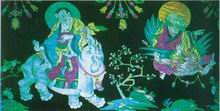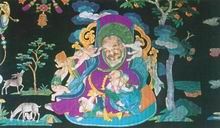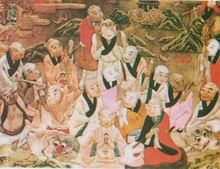| The appliqued embroidery

Duisui embroidery
is a sort of Tangka that is a kind of scroll painting mounted
on silk. It has distinctive ethnic features and a strong religious
flavor. Ta’er Lamasery is famous for its Tangka of unique artistic
style.
Most Tangkas are painted on cloth, silk or paper, but there are
also Tangkas of embroidery, brocade and applique. Embroidery Tangka
is done with silk thread of different colors, depicting landscapes,
figures, flowers, feathers, pavilions and towers. Brocade Tangkas
are woven on jacquard looms, with warp-and-weft patterns. Applique
Tangkas are made by pasting figures and patterns of colored silk
on a background material; and kesi Tangkas are like relief sculpture,
with a three-dimensional effect, something like a special handicraft
combining the art of painting with silk weaving. These fabric
Tangkas have compact compositions, fine patterns and bright colors.
They are of close texture and very decorative. Some Tangkas are
inlaid with pearls and precious stones. At first, most fabrics
used for making Tangkas were made in the interior. Later, Tibet
developed embroidery and applique Tangkas. There are also Tangkas
made from woodblock prints, the working procedures including painting
the original design, engraving the block, printing, color application
and mounting.
Tangkas depict a wide range of themes taken from Tibetan history,
social life, folk customs, astronomy, the calendar and traditional
Tibetan medicine. Using paintings to reflect history is a remarkable
characteristic of Tangkas. Tangkas depicting the general history
of Tibet are composed of scenes of important events at various
stages of Tibetan history, together with captions. Tangkas depicting
dynastic history portray scenes of historical periods, reflecting
relevant historical events. There is another kind of Tangkas portraying
the life stories of certain personages (including religious figures).
Ta’er Lamasery houses a Tangka of an atlas of celestial bodies.
Each planet is in the form of an animal, symbolizing one of the
12 heavenly bodies moving in its own orbit. It is an important
cultural relic for the study of ancient astronomy and the Tibetan calendar. Norbu Lingka houses a complete set of medical
Tangkas, totaling 62 paintings and showing medical principles,
the structure of the human body, acupoints on the channels and
collaterals of the body, medical apparatus and pharmaceuticals.
In the 17th century, during the reign of Sanggyai Gyaco, famous
painters from various parts of Tibet were summoned to make a complete
set of Tangkas illustrating the corpus of Tibetan medicine.
Tibetan calendar. Norbu Lingka houses a complete set of medical
Tangkas, totaling 62 paintings and showing medical principles,
the structure of the human body, acupoints on the channels and
collaterals of the body, medical apparatus and pharmaceuticals.
In the 17th century, during the reign of Sanggyai Gyaco, famous
painters from various parts of Tibet were summoned to make a complete
set of Tangkas illustrating the corpus of Tibetan medicine.
The content of Thangka has various subject matters such as historical
incident, personage biographies, religion doctrines, Tibetan natural
conditions and social customs, folklores, mythical stories etc.
involving politic, economic, history, religion, literature and
art, social life and many other respects. So Thangka is praised
as a visual encyclopedia.
page
up |



